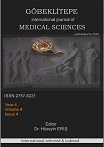EVALUATION OF THE USE OF THE OMAHA SYSTEM IN THE CARE OF THE ELDERLY LIVING IN A NURSING HOME: DOCUMENT ANALYSIS
Keywords:
Omaha System, Elderly, Nursing Home, Public Health Nursing, PracticeAbstract
Aim: The aim of this study is to evaluate the use of the Omaha system in the care of the elderly living in a nursing home. Method: The data of the study were compiled from the care plans prepared by 60 students in line with the Omaha System for 60 elderly people within the scope of public health nursing course nursing home practices. The data drawn from the care plans were analyzed using the SPSS 16 program. Descriptive statistics and paired sample t-test were used to evaluate the data. Permission was obtained from the institution and the elderly before the application. Results: It was determined that a total of 1118 nursing diagnoses were made by the nursing students, 42.4% in the physiological, 28.9% in the psychosocial, 21.7% in the health behaviors and 7% in the environmental field. In the environmental area, income (29.5%) and housing (28.2%); emotional balance in the psychosocial domain (26.9%) and social relations (17.6%); neuromusculoskeletal functions (21.5%) and cognitive status (11.8%) in the physiological domain; In the field of health behaviors, nutrition (25.9%) and sleep-rest (20.5%) were the most commonly used areas of disability. It was also seen that 6587 nursing interventions were planned for the identified diagnoses, but 3967 of them were carried out. It was determined that 54.9% of the interventions were in the categories of health education, guidance and counseling, 37.3% in the follow-up, 4.3% in the case management and 3.5% in the treatment procedure categories. When interventions were evaluated by comparing the first and last follow-up scores separately in the Problem Assessment Scale (PBL) knowledge, behavior and status categories, a statistically significant increase was found in general (p<0.05). Conclusion: It was determined that the students made nursing diagnoses in physiological, psychosocial, health behaviors and environmental areas, respectively, and that the students did not implement about half of the interventions they planned. The results of nursing students' care for the elderly in line with the Omaha System were found to be effective





